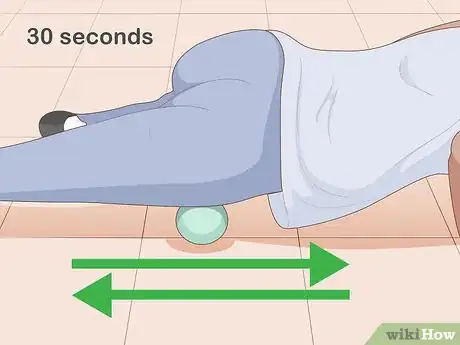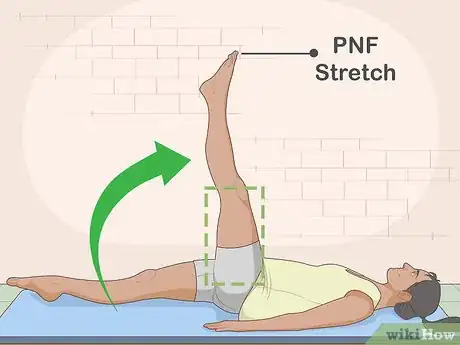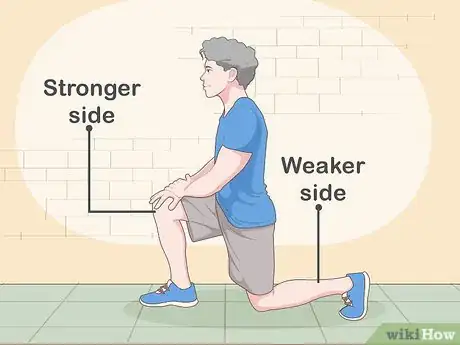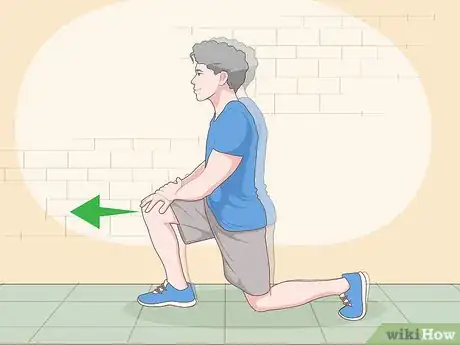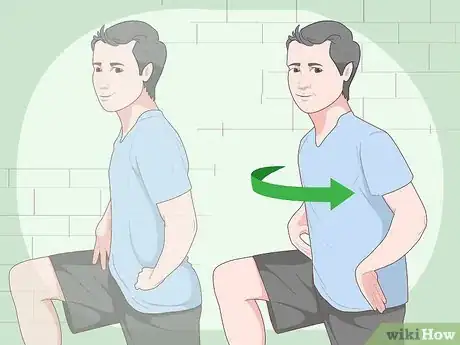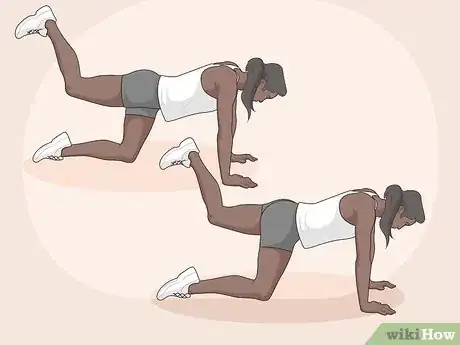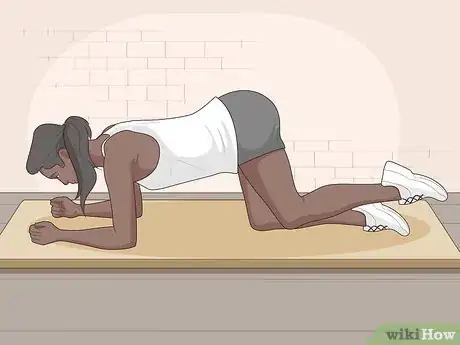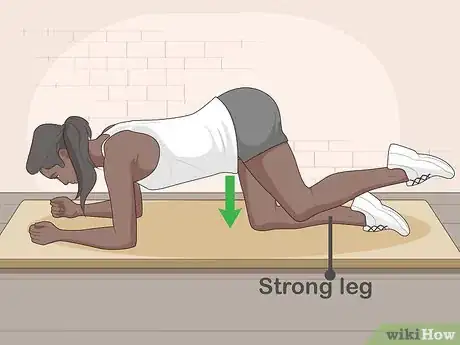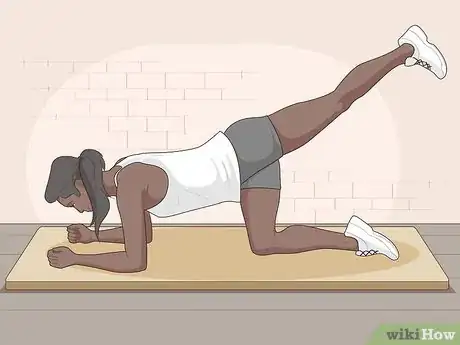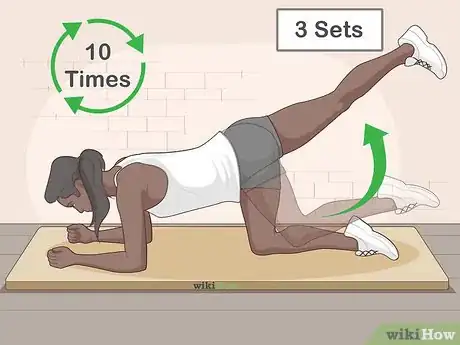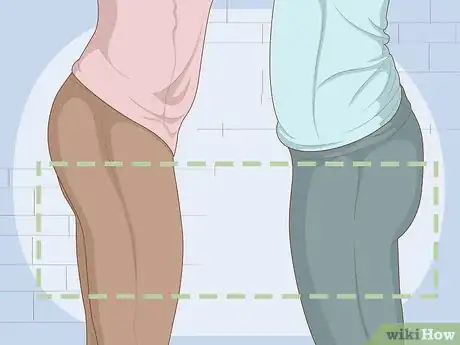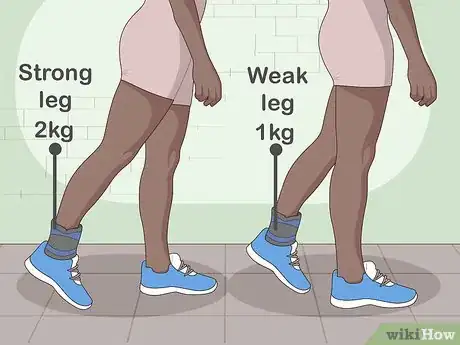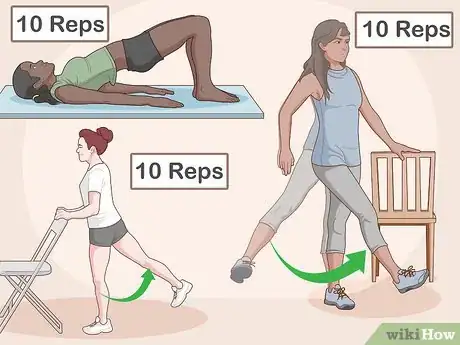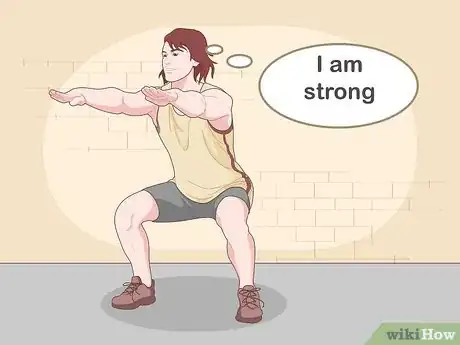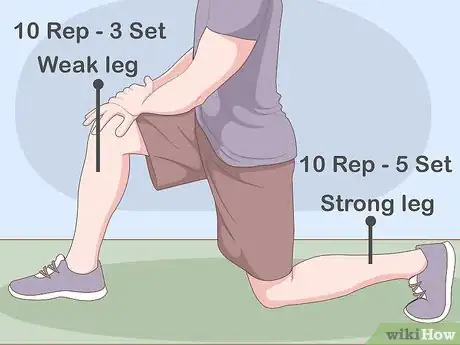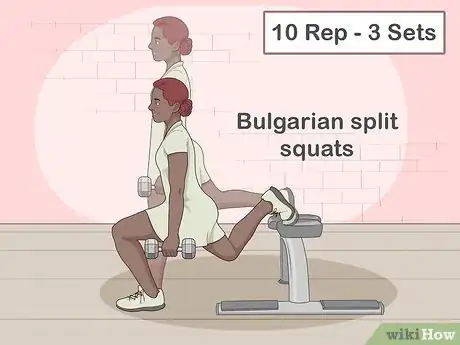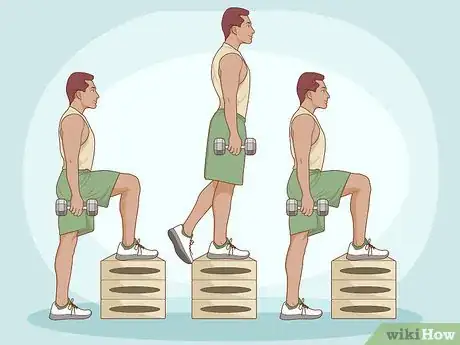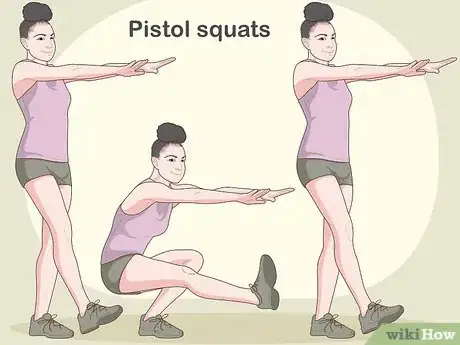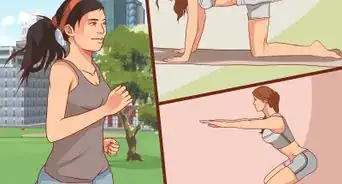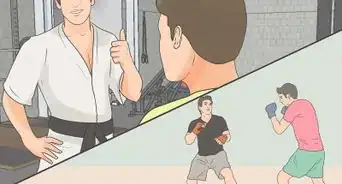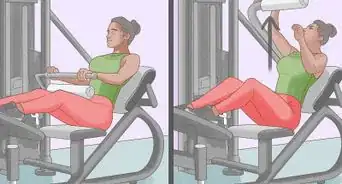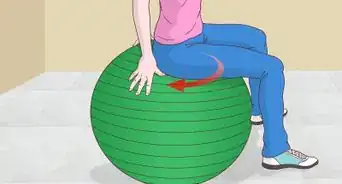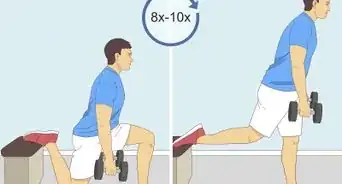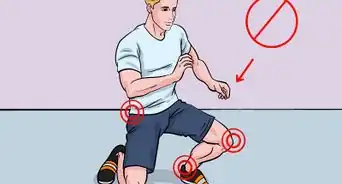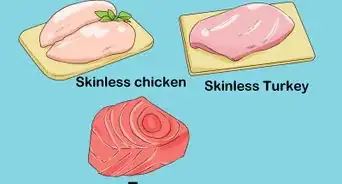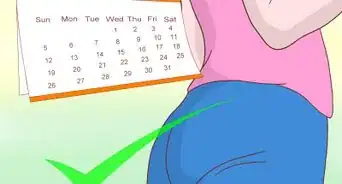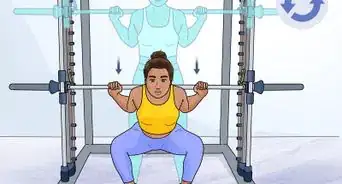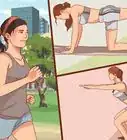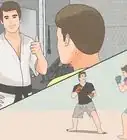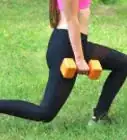This article was co-authored by Cassie Wakin. Cassie Wakin is a Pain & Posture Specialist based in Austin, Texas. With more than 11 years of experience, she specializes in fitness coaching, intuitive eating nutrition counseling, and addressing back pain, poor posture, and joint pain. Cassie holds a Human Biomechanics Specialist Certification from Functional Patterns and is an Anthem Award winning trainer.
There are 13 references cited in this article, which can be found at the bottom of the page.
This article has been viewed 62,271 times.
Having uneven glutes can be frustrating, especially if you've been targeting them in your workout. However, it’s normal for glutes to be uneven, and oftentimes the glute on your dominant side will be stronger and firmer. If you have an extreme difference, it could be because of bad exercise form, poor posture, or reduced mobility. Fortunately, there are techniques for evening out your glutes. Start by activating your glutes to make sure they are getting the benefit of your workout. Then address issues in your workout that may be causing the imbalance. Finally, you can work your weaker side more than your stronger side, which can help it “catch up” to the stronger side.
Steps
Activating Your Glutes
-
1Roll out your muscles using a ball or foam roller. Before performing your extension exercises, loosen the hip on your weak side by rolling out the muscle. Lie face-down on the floor with the ball or foam roller positioned under your hip on the weaker side. Using your hands to support you, move your hips back and forth (front to back) over the ball or roller. Continue for 30 seconds to loosen the hip.[1]
- This activity will help you increase your hip extension range-of-motion, and allow your weaker glute to build up some more strength.
- While on the ball or roller, you can also do slight extension stretches by lifting your leg on the side you are working just slightly, then lowering.
-
2Activate your glutes using a stretch. Activation is great for glutes that aren’t getting the full benefit of your workout because they are not fully engaged. You can activate your glutes using a stretch called a proprioceptive neuromuscular facilitation (PNF) stretch, which is a type of flexibility stretch that loosens up the front of your thighs. Do the exercise only on the side that isn’t getting good glute activation.[2]
- Tightness in the front of your thighs can prevent your thighs from making backwards movements, which work your glutes. However, stretching the front of your hip while alternately contracting the back of your hip can help loosen and activate your glutes.
Advertisement -
3Move into a lunge position with the leg on your stronger side in front. Your legs do not need to be that far apart because you are going to be switching up the move to create a stretch.[3]
- It’s best to do this on an exercise mat to protect your knees.
-
4Lower yourself until the leg on your weaker side rests on the floor. Press your toes of that foot into the floor, with your foot perpendicular to the ground. The leg on your stronger side should remain bent with your foot flat against the floor. Place your hands on your hips.[4]
-
5Tuck your pelvis in, squeezing your abs and glutes. Keep straight through your core as you do the stretch. Really focus on your glute muscles, as this is your target area.[5]
- Squeeze your glutes hard as you slowly move forward just slightly. Your movement should be slow and focused so that you can concentrate on feeling the stretch in the front of your thigh muscles. Be careful not to extend your knee far out over your foot. The movement forward and back should be slight, but try to go a little deeper each time.[6]
- Relax your glutes as you go back to the starting position.
- Do 3 sets of 10-15 reps.
Performing Hip Extensions
-
1Use hip extensions to open up your glute range. Sometimes your glutes are unable to work effectively if you are unable to fully extend through your hip. This could be preventing development in your weaker glute. You can incorporate hip extensions into your workout to open your weaker side.[7]
-
2Kneel on an exercise mat, then lean forward and rest on your elbows. Both of your forearms should be flat against the mat, as should your shins. This is the same position as “being on all fours.”[8]
- You can do this move without the mat, but it may be uncomfortable, especially for your knees.
-
3Shift your weight to your stronger side. Slightly lift your weaker leg behind you. The leg on your weaker side should hover just over the floor, ready to be extended backward. Make sure that the leg on your stronger side is balanced and that you aren’t wobbly.[9]
- It’s important that you remain stable and balanced throughout the move, since you could strain something if your form is off. Additionally, you would not get the full benefit of the workout.
-
4Extend the leg on your weaker side behind you and slightly up. Squeeze your glutes as you extend your leg. Go as far as you can comfortably, feeling the contraction of your glute muscles. Push your heel away from your body.
- Your leg should extend straight out behind you. At first, your knee may be bent slightly. This is okay, but you will want to make progress toward straightening that leg over time.[10]
-
5Return to the starting position, then repeat 10 times. Bring your knee back down, stopping just behind your stationary knee. This will keep your glutes engaged the entire time you are working them.
- Make sure your back is not turning as you lift the leg up. Your back should stay still throughout the leg lift.
- Sometimes when doing this move you bring your working leg up under you and into your chest, but this can relax the glutes. You can maximize your glute benefit by not bringing in your knee.[11]
- Do 3 sets.
Addressing Issues in Your Workout
-
1Check your form to make sure it’s symmetrical. When you perform your normal workout, watch or film yourself to make sure that you are using the correct stance and follow through. It’s possible that you are not performing your moves symmetrically, which could be causing your uneven glutes.[12]
- This can be difficult to notice yourself, since the imbalance may be subtle. For example, you may be slightly tucked on one side. It's best to have a professional help you with your form.
- Remember—all your muscles are connected! The glute isn't independent of your other muscles, like your quadriceps or hamstring.[13]
-
2Use lighter loads when correcting your symmetry. If you do find that you are putting more of your weight to the stronger side, go back to basics to work on your form. You can use a lighter load or do the moves without weights, depending on your typical workout. This applies to moves like squats or deadlifts.[14]
- For example, someone who lifts very heavy might continue to use lighter weights, while someone who uses light dumbbells could benefit from doing the moves without weights until they fix their form.
-
3Increase your hip mobility and stretch the front of your hips. It’s a good idea to do the glute activation stretch above before any workout, but you can also add additional stretches. Good options include bridges, leg swings, and leg crossovers.
- To do a bridge, lay on the floor with your knees bent and your feet flat on the floor. Squeeze your glutes, then slowly push your torso off the ground so that you are resting on your shoulder blades and feet. Then lower back to the starting position. Do 10 repetitions.
- To do leg swings, place your hand against the wall or a chair for stability. Lift the leg you are working out to your side as high as you comfortably can, squeezing your glutes. Lower to the starting position and repeat 10 times. Switch legs and do the other side.
- To do leg crossovers, place your hand against the wall or a chair for stability. Move the working leg out to the side with your toe pointed. Squeeze your glutes, then lift the working leg and cross it in front of your stationary leg, stopping when you feel the stretch. Return to the starting position. Repeat for 10 repetitions, then switch sides.
-
4Work on your mind-muscle connections. As you work your glutes, focus your thoughts on working that muscle group. You can also enhance that thought connection by poking the muscles as you work them.[15]
- Use short mantras to call your attention to your muscles and what you feel in your body. You could say, “Firm and tight,” “I am strong,” or “Show your power.”
- Set a goal for your glutes and repeat this goal to yourself as you exercise. Say, “My glutes are firm and balanced. I move with symmetry.” Picture yourself fulfilling this goal.
- Take a moment between sets to refocus yourself on your goals and take stock of how your body feels. Get back into position and really think about the work you plan to do.[16]
Targeting the Weaker Glute
-
1Perform extra lunges on your weaker side. Place your foot on your weaker side out in front of you, and your other foot behind you in a standing-splits position. Spread your legs as far apart as you comfortably can to better target the glutes rather than your quads. Push down into your heel on your front leg and tip your torso slightly forward and backward until you find the exact position where you feel your glutes working the most. Slowly lower yourself until your front knee is in line with your ankle, then slowly rise to a standing position. [17]
- Repeat for 10 repetitions, and do 3 sets.
- Alternatively, you can add more weight on your weaker side if you do weighted lunges.
-
2Try Bulgarian split squats to strengthen your weaker side. Split squats are like lunges, but you will place the foot of one leg on a bench, box, or chair to better work the muscle.[18] Place the foot of your weaker side on the floor, then lift your other leg behind you, placing your foot top-side down on a stable surface, such as your weight bench. Slowly lower your body until your knee is positioned over your ankle. Hold the contraction for a second, then slowly rise back to a standing position.[19]
- Complete 3 sets of 10 split squats.
-
3Do weighted step-ups on your weaker side. Place a sturdy box or bench in front of you. Alternatively, you could stand in front of a step. Stand with your feet shoulder-width apart. Holding your weights, step up on your weak side. Bring up your other leg as well, ending with you standing on the step. Then step back down starting with the foot on your stronger side.[20]
- Before you do the move, adjust your body positioning until you really feel your glutes working. Maintain this position with each repetition, making sure you are correctly using your glutes.
- Do 3 sets of 10 repetitions.
-
4Perform pistol (single leg) squats.[21] In a standing position, lift your arms out in front of you. Firmly plant the leg on your weaker side, then lift your other leg as high as you can while remaining balanced. With your back straight, gently lower yourself into a squat, keeping your leg lifted. Slowly rise back to your starting position to complete the squat.[22]
- Complete 3 sets of 10 split squats.
Expert Q&A
-
QuestionWhy are my buttocks uneven?
 Cassie WakinCassie Wakin is a Pain & Posture Specialist based in Austin, Texas. With more than 11 years of experience, she specializes in fitness coaching, intuitive eating nutrition counseling, and addressing back pain, poor posture, and joint pain. Cassie holds a Human Biomechanics Specialist Certification from Functional Patterns and is an Anthem Award winning trainer.
Cassie WakinCassie Wakin is a Pain & Posture Specialist based in Austin, Texas. With more than 11 years of experience, she specializes in fitness coaching, intuitive eating nutrition counseling, and addressing back pain, poor posture, and joint pain. Cassie holds a Human Biomechanics Specialist Certification from Functional Patterns and is an Anthem Award winning trainer.
Pain & Posture Specialist One of your glutes is likely more connected and aligned than the other. Focus on creating better alignment and connectivity in your glutes by aligning the pelvis correctly with the ribcage, knee, foot, and hamstring.
One of your glutes is likely more connected and aligned than the other. Focus on creating better alignment and connectivity in your glutes by aligning the pelvis correctly with the ribcage, knee, foot, and hamstring.
Warnings
- If you work out too hard on your weaker glute, you may accidentally create an imbalance on the other side.⧼thumbs_response⧽
References
- ↑ https://www.youtube.com/watch?v=P87rvk7wIec&feature=youtu.be&t=180
- ↑ https://www.youtube.com/watch?v=P87rvk7wIec&feature=youtu.be&t=209
- ↑ https://www.youtube.com/watch?v=P87rvk7wIec&feature=youtu.be&t=209
- ↑ https://www.youtube.com/watch?v=P87rvk7wIec&feature=youtu.be&t=209
- ↑ https://www.youtube.com/watch?v=P87rvk7wIec&feature=youtu.be&t=209
- ↑ https://www.youtube.com/watch?v=P87rvk7wIec&feature=youtu.be&t=209
- ↑ https://www.youtube.com/watch?v=P87rvk7wIec&feature=youtu.be&t=114
- ↑ https://www.youtube.com/watch?v=fhqfgyhQATY
- ↑ https://www.youtube.com/watch?v=fhqfgyhQATY
- ↑ https://www.youtube.com/watch?v=fhqfgyhQATY
- ↑ https://www.youtube.com/watch?v=fhqfgyhQATY
- ↑ https://bretcontreras.com/how-to-fix-glute-imbalances/
- ↑ Cassie Wakin. Pain & Posture Specialist. Expert Interview. 7 December 2021.
- ↑ https://bretcontreras.com/how-to-fix-glute-imbalances/
- ↑ https://www.youtube.com/watch?v=P87rvk7wIec&feature=youtu.be&t=290
- ↑ https://www.bodybuilding.com/content/3-ways-to-build-a-better-mind-muscle-connection.html
- ↑ https://www.bodybuilding.com/content/glute-workout-5-moves-to-a-better-butt.html
- ↑ https://www.bodybuilding.com/content/glute-workout-5-moves-to-a-better-butt.html
- ↑ http://www.exrx.net/WeightExercises/Quadriceps/BWSingleLegSplitSquat.html
- ↑ http://www.exrx.net/WeightExercises/Quadriceps/DBStepUp.html
- ↑ Danny Gordon. Certified Personal Trainer. Expert Interview. 18 October 2019.
- ↑ http://www.exrx.net/WeightExercises/Quadriceps/BWSingleLegSquat.html
